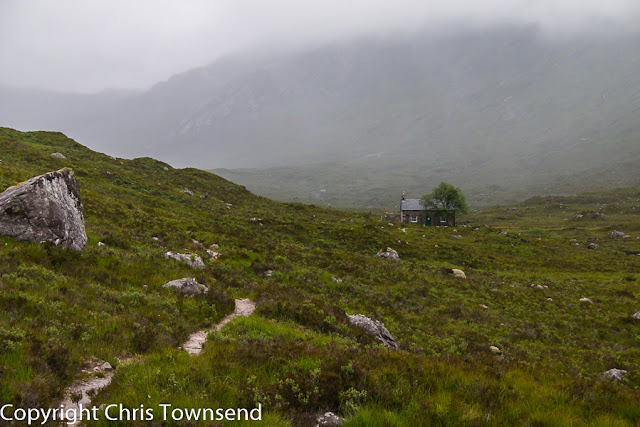 |
| A frosty camp looking towards Sgor Gaoith |
Sunshine. Cold. Snow. Just how winter should be. And for a
few days it was. High level camping in winter is a joy in conditions like this.
Deciding to combine such a camp with ski touring I headed for a favourite area
for both activities, the Moine Mhor plateau above Glen Feshie.
 |
| The Arctic landscape of the Moine Mhor |
Once I reached the Moine Mhor a white Arctic-like world
opened up. This world was white and vast with endless snowfields stretching out
to distant peaks. As I ventured out onto the great whiteness the snow-free
glens and the dark woods far below disappeared and all that was left was snow,
broken only by occasional dark rocks poking through the white blanket.
Easy skiing led out into the heart of the whiteness. The
skis skimmed over the snow. Long straight effortless runs let me admire the
wild scene as I sped along. At times I made wide sweeping turns, the skis
slicing through the soft snow. There cannot be an easier way to traverse a
snowy landscape.
 |
| Last of the sun on Braeriach |
As the sun touched the horizon and long shadows started to
spread across the snow I decided it was time to stop. In these conditions a
camp can be made almost anywhere. I selected a shallow curve of deep snow. The
high tops were turning pink in the last of the sun as I pitched the tent in
rapidly dropping temperatures.
 |
| A starry sky |
Later in the evening the sky was a mass of brilliant stars
curving over the dark land. I fell asleep looking up at the constellation of
the Plough directly above, my head in the open door of the tent. Brightness
woke me at 1.30. The moon had risen and the hills were visible again. A heavy
frost had coated the tent white inside and out. The temperature was -12.6°C.
Crouched in the doorway I took photographs of moonlit Sgor Gaoith (you can see
the shadow of my tent and tripod in the pictures) before dozing off again.
 |
| Sgor Gaoith by moonlight |
When I next awoke the sun was just appearing over the
horizon. The shadowed snow turned white again, the black sky lightened to a
bright blue. The stars and moon had vanished. The temperature was still -6°C.
It would take the sun a while to heat the air. A mug of hot chocolate and
muesli porridge gave me the energy to leave my sleeping bag and wander round
the camp watching the world come back to life.
 |
| A cold start to the day |
Finally leaving my camp, one of the finest for many months,
I headed to the shallow gully of the snow-hidden Allt Sgairnich, where I have
built igloos in the past. Today the wind had carved steep banks above the
stream and there were several well-built snowholes high up on these. Climbing
out of the gully onto Carn Ban Mor I saw many people heading for Sgor Gaoith.
Out on the Moine Mhor I’d seen one other skier, now I could see dozens of
walkers and there was a well-tramped path leading to the summit.
 |
| Allt Sgairnich snowholes |
Everyone was rewarded for their efforts – and walking in the
soft snow looked much harder than skiing – as the views were as superb as they
always are in clear weather from the tiny summit of Sgor Gaoith. Far below dark
Loch Einich was part-frozen. The peak of the winds lived up to its name and a
bitter wind swept the summit.
 |
| Loch Einich & Braeriach from Sgor Gaoith |
A long traversing descent took me below the walkers’ route
and across lovely snow where turns were easy to the col with Carn Ban Beag. From
here it was just a walk back down into Glen Feshie, my mind full of the arctic
landscape high above.














